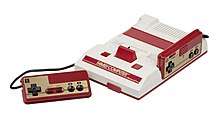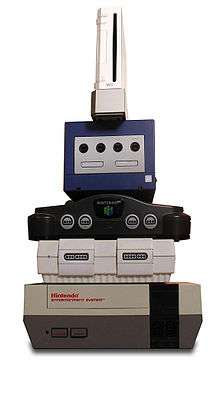Nintendo Entertainment System
The Nintendo Entertainment System (NES) is an 8-bit third-generation home video game console produced, released, and marketed by Nintendo. It is a remodelled export version of the company's Family Computer[lower-alpha 1] (FC) platform in Japan, commonly known as the Famicom,[lower-alpha 2] which was launched on July 15, 1983. The NES was launched in a test market of New York City on October 18, 1985, followed by Los Angeles as a second test market in February 1986, followed by Chicago and San Francisco, then other top 12 American markets, followed by a full launch across North America and some countries in Europe in September 1986, followed by Australia and other countries in Europe in 1987. Brazil saw only unlicensed clones until the official local release in 1993. The console's South Korean release was packaged as the Hyundai Comboy[lower-alpha 3] and distributed by Hyundai Electronics (now SK Hynix).
| |
Top: NES Control deck (with detatchable controllers). Bottom: Japanese Family Computer ("Famicom") main unit (with the hardwired controllers). | |
| Also known as | Family Computer/Famicom (Japan) Hyundai Comboy (Korea) Samurai (India) |
|---|---|
| Developer | Nintendo R&D2 |
| Manufacturer | Nintendo |
| Type | Home video game console |
| Generation | Third generation |
| Release date | |
| Lifespan | 1983–2003 (Famicom)[2] 1985–1995 (NES) |
| Introductory price | ¥14,800 (Japan) $179 (US Deluxe Set)[3] |
| Discontinued | |
| Units sold | Worldwide: 61.91 million Japan: 19.35 million America: 34.00 million Other: 8.56 million[7] |
| Media | ROM cartridge ("Game Pak")[b] |
| CPU | Ricoh 2A03 8-bit processor (MOS Technology 6502 core) |
| Controller input | 2 controller ports[c] 1 expansion slot |
| Best-selling game |
|
| Predecessor | Color TV-Game series |
| Successor | Super Nintendo Entertainment System |
| Related articles | Famicom Disk System, Famicom 3D System |
As one of the best-selling gaming consoles of its time, the NES helped revitalize the US video game industry following the video game crash of 1983.[11] With the NES, Nintendo introduced a now-standard business model of licensing third-party developers, authorizing them to produce and distribute games for Nintendo's platform.[12] It had been preceded by Nintendo's first home video game console, the Color TV-Game, and was succeeded by the Super Nintendo Entertainment System (SNES).
History
Development
Following a series of arcade game successes in the early 1980s, Nintendo made plans to create a cartridge-based console called the Family Computer, or Famicom. Masayuki Uemura (ja) designed the system.[13][14] Original plans called for an advanced 16-bit system which would function as a full-fledged computer with a keyboard and floppy disk drive, but Nintendo president Hiroshi Yamauchi rejected this and instead decided to go for a cheaper, more conventional cartridge-based game console as he believed that features such as keyboards and disks were intimidating to non-technophiles. A test model was constructed in October 1982 to verify the functionality of the hardware, after which work began on programming tools. Because 65xx CPUs had not been manufactured or sold in Japan up to that time, no cross-development software was available and it had to be produced from scratch. Early Famicom games were written on a system that ran on an NEC PC-8001 computer and LEDs on a grid were used with a digitizer to design graphics as no software design tools for this purpose existed at that time.[15]
The code name for the project was "GameCom", but Masayuki Uemura's wife proposed the name "Famicom", arguing that "In Japan, 'pasokon' is used to mean a personal computer, but it is neither a home or personal computer. Perhaps we could say it is a family computer." Meanwhile, Hiroshi Yamauchi decided that the console should use a red and white theme after seeing a billboard for DX Antenna (a Japanese antenna manufacturer) which used those colors.[15]
The creation of the Famicom was hugely influenced by the ColecoVision, Coleco's competition against the Atari 2600 in the United States. Takao Sawano, chief manager of the project, brought a ColecoVision home to his family, who were impressed by the system's capability to produce smooth graphics at the time,[16] which contrasts with the flicker and slowdown commonly seen on Atari 2600 games. Uemura, head of Famicom development, stated that the ColecoVision set the bar for the Famicom.[17]
Original plans called for the Famicom's cartridges to be the size of a cassette tape, but ultimately they ended up being twice as big. Careful design attention was paid to the cartridge connectors because loose and faulty connections often plagued arcade machines. As it necessitated 60 connection lines for the memory and expansion, Nintendo decided to produce its own connectors.[15]
The controllers are hard-wired to the console with no connectors for cost reasons. The game pad controllers were more-or-less copied directly from the Game & Watch machines, although the Famicom design team originally wanted to use arcade-style joysticks, even dismantling some from American game consoles to see how they worked. There were concerns regarding the durability of the joystick design and that children might step on joysticks on the floor. Katsuyah Nakawaka attached a Game & Watch D-pad to the Famicom prototype and found that it was easy to use and caused no discomfort. Ultimately though, they installed a 15-pin expansion port on the front of the console so that an optional arcade-style joystick could be used.[15]
Gunpei Yokoi suggested an eject lever to the cartridge slot which is not really necessary, but he believed that children could be entertained by pressing it. Uemura adopted his idea. Uemura added a microphone to the second controller with the idea that it could be used to make players' voices sound through the TV speaker.[18][15]
Release
The console was released on July 15, 1983 as the Family Computer (or Famicom) for ¥14,800 (equivalent to ¥18,400 in 2019) alongside three ports of Nintendo's successful arcade games Donkey Kong, Donkey Kong Jr. and Popeye. The Famicom was slow to gather momentum; a bad chip set caused the initial release of the system to crash. Following a product recall and a reissue with a new motherboard, the Famicom's popularity soared, becoming the best-selling game console in Japan by the end of 1984.[19]:279, 285
Nintendo also had its sights set on the North American market, entering into negotiations with Atari to release the Famicom under Atari's name as the Nintendo Advanced Video Gaming System. The deal was set to be finalized and signed at the Summer Consumer Electronics Show in June 1983. However, Atari discovered at that show that its competitor Coleco was illegally demonstrating its Coleco Adam computer with Nintendo's Donkey Kong game. This violation of Atari's exclusive license with Nintendo to publish the game for its own computer systems delayed the implementation of Nintendo's game console marketing contract with Atari. Atari's CEO Ray Kassar was fired the next month, so the deal went nowhere, and Nintendo decided to market its system on its own.[19]:283–285[g]
.jpg)
Subsequent plans for the Nintendo Advanced Video System likewise never materialized: a North American repackaged Famicom console featuring a keyboard, cassette data recorder, wireless joystick controller, and a special BASIC cartridge.[19]:287 By the beginning of 1985, more than 2.5 million Famicom units had been sold in Japan, and Nintendo soon announced plans to release it in North America as the Advanced Video Entertainment System (AVS) that same year. The American video game press was skeptical that the console could have any success in the region, as the industry was still recovering from the video game crash of 1983. The March 1985 issue of Electronic Games magazine stated that "the videogame market in America has virtually disappeared" and that "this could be a miscalculation on Nintendo's part".[20]
At June 1985's Consumer Electronics Show (CES), Nintendo unveiled the American version of its Famicom, with a new case redesigned by Lance Barr and featuring a "zero insertion force" cartridge slot.[21] The change from a top-loader in the Famicom to a front-loader was to make the new console more like a video cassette recorder, which had grown in popularity by 1985, and differentiate the unit from past video game consoles.[22] Additionally, Uemura explained that Nintendo developers had feared that the console's electronics might face electrostatic hazards in dry American states such as Arizona and Texas, and a front-loading design would be safer if children handled the console carelessly.[23]
This would eventually be officially deployed as the Nintendo Entertainment System, or the colloquial "NES". Nintendo seeded these first systems to limited American test markets starting in New York City on October 18, 1985, and followed up with a full North American release in February 1986.[24] The nationwide release came in September 1986. Nintendo released 17 launch games: 10-Yard Fight, Baseball, Clu Clu Land, Duck Hunt, Excitebike, Golf, Gyromite, Hogan’s Alley, Ice Climber, Kung Fu, Pinball, Soccer, Stack-Up, Super Mario Bros., Tennis, Wild Gunman and Wrecking Crew.[25][h] For expedient production, some varieties of these launch games contain Famicom chips with an adapter inside the cartridge so they play on North American consoles, which is why the title screens of Gyromite and Stack-Up have the Famicom titles "Robot Gyro" and "Robot Block", respectively.[26]

The system's launch represented not only a new product, but also a reframing of the severely damaged home video game market. The 1983 video game crash had occurred in large part due to a lack of consumer and retailer confidence in video games, which had been partially due to confusion and misrepresentation in video game marketing. Prior to the NES, the packaging of many video games presented bombastic artwork which exaggerated the graphics of the actual game. In terms of product identity, a single game such as Pac-Man would appear in many versions on many different game consoles and computers, with large variations in graphics, sound, and general quality between the versions. In stark contrast, Nintendo's marketing strategy aimed to regain consumer and retailer confidence by delivering a singular platform whose technology was not in need of exaggeration and whose qualities were clearly defined.
To differentiate Nintendo's new home platform from the perception of a troubled and shallow video game market still reeling from the 1983 crash, the company freshened its product nomenclature and established a strict product approval and licensing policy. The overall platform is referred to as "Entertainment System" instead of a "video game system", is centered upon a machine called a "Control Deck" instead of a "console", and features software cartridges called "Game Paks" instead of "video games". This allowed Nintendo to gain more traction in selling the system in toy stores.[27][28] To deter production of games which had not been licensed by Nintendo, and to prevent copying, the 10NES lockout chip system act as a lock-and-key coupling of each Game Pak and Control Deck. The packaging of the launch lineup of NES games bear pictures of close representations of actual onscreen graphics. To reduce consumer confusion, symbols on the games' packaging clearly indicate the genre of the game. A seal of quality is on all licensed game and accessory packaging. The initial seal states, "This seal is your assurance that Nintendo has approved and guaranteed the quality of this product". This text was later changed to "Official Nintendo Seal of Quality".[29]
Unlike with the Famicom, Nintendo of America marketed the console primarily to children, instituting a strict policy of censoring profanity, sexual, religious, or political content. The most famous example is Lucasfilm's attempts to port the comedy-horror game Maniac Mansion to the NES, which Nintendo insisted be considerably watered down. Nintendo of America continued its censorship policy until 1994 with the advent of the Entertainment Software Rating Board system, coinciding with criticism stemming from the cuts made to the Super NES port of Mortal Kombat compared to the Sega Genesis'.
The optional Robotic Operating Buddy, or R.O.B., was part of a marketing plan to portray the NES's technology as being novel and sophisticated when compared to previous game consoles, and to portray its position as being within reach of the better established toy market. Though at first, the American public exhibited limited excitement for the console itself, peripherals such as the light gun and R.O.B. attracted extensive attention.[30]
In Europe and Oceania the system was released in two separate marketing regions. The first consisted of mainland Europe (excluding Italy) where distribution was handled by a number of different companies, with Nintendo responsible for manufacturing. Most of this region saw a 1987 release. The release in Scandinavia was in 1986, where it was released by Bergsala. In the Netherlands, it was distributed by Bandai BV.[31] In 1987 Mattel handled distribution for the second region, consisting of the United Kingdom, Ireland, Italy, Australia and New Zealand. Mattel also handled distribution for Nintendo in Canada, however it was unrelated to the aforementioned European / Australian releases.[32]
In Brazil, the console was released late in 1993 by Playtronic, even after the SNES. But the Brazilian market had been dominated by unlicensed NES clones — both locally made, and smuggled from China and Taiwan.[33] One of the most successful local clones is the Phantom System, manufactured by Gradiente, which would end up licensing Nintendo products in the country for the following decade.[34] The sales of officially licensed products were low, due to the cloning, the quite late official launch, and the high prices of Nintendo's licensed products.[35]
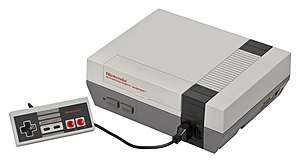
For its complete North American release, the Nintendo Entertainment System was progressively released over the ensuing years in several different bundles, beginning with the Deluxe Set, the Basic Set, the Action Set and the Power Set. The Deluxe Set, retailing at US$179.99 (equivalent to $462 in 2019),[3] included R.O.B., a light gun called the NES Zapper, two controllers, and two Game Paks: Gyromite, and Duck Hunt. The Basic Set, first released in 1987, retailed at US$89.99 with no game, and US$99.99 bundled with the Super Mario Bros. cartridge. The Action Set, retailing in November 1988 for US$149.99, came with the Control Deck, two game controllers, an NES Zapper, and a dual Game Pak containing both Super Mario Bros. and Duck Hunt.[4][19]:305 In 1989, the Power Set included the console, two game controllers, an NES Zapper, a Power Pad, and a triple Game Pak containing Super Mario Bros, Duck Hunt, and World Class Track Meet. In 1990, a Sports Set bundle was released, including the console, an NES Satellite infrared wireless multitap adapter, four game controllers, and a dual Game Pak containing Super Spike V'Ball and Nintendo World Cup.[36] Two more bundle packages were later released using the original model NES console. The Challenge Set of 1992 included the console, two controllers, and a Super Mario Bros. 3 Game Pak for a retail price of US$89.99. The Basic Set was repackaged for a retail US$89.99. It included only the console and two controllers, and no longer was bundled with a cartridge.[36] Instead, it contained a book called the Official Nintendo Player's Guide, which contained detailed information for every NES game made up to that point.
Finally, the console was redesigned for both the North American and Japanese markets as part of the final Nintendo-released bundle package. The package included the new style NES-101 console, and one redesigned "dogbone" game controller. Released in October 1993 in North America, this final bundle retailed for US$49.99 and remained in production until the discontinuation of the NES in 1995.[4]
Discontinuation
On August 14, 1995, Nintendo discontinued the Nintendo Entertainment System in both North America and Europe.[37] In North America, replacements for the original front-loading NES were available for $25 in exchange for a broken system until at least December 1996, under Nintendo's Power Swap program. The Game Boy and Super Nintendo were also covered in this program, for $25 and $35 respectively.[38]
The Famicom was officially discontinued in September 2003. Nintendo offered repair service for the Famicom in Japan until 2007, when it was discontinued due to a shortage of available parts.[37]
Hardware
Configurations
Although the Japanese Famicom, North American and European NES versions included essentially the same hardware, there were certain key differences among the systems.
The original Japanese Famicom was predominantly white plastic, with dark red trim. It featured a top-loading cartridge slot, grooves on both sides of the deck in which the hardwired game controllers could be placed when not in use, and a 15-pin expansion port located on the unit's front panel for accessories.[39]
The original NES, meanwhile, featured a front-loading cartridge covered by a small, hinged door that can be opened to insert or remove a cartridge and closed at other times. It features a more subdued gray, black, and red color scheme. An expansion port was found on the bottom of the unit and the cartridge connector pinout was changed.
In the UK, Italy and Australia which all share the PAL-A region, the "Mattel Version" of the NES released, with the UK also receiving the "NES Version" of the NES and Italy later receiving the "Versione Italiana" NES.[40] When the NES was first released in those countries, it was distributed by Mattel and Nintendo decided to use a lockout chip specific to those countries, different from the chip used in other European countries.
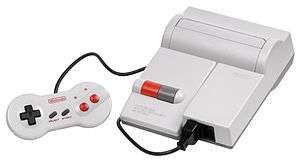
In October 1993, Nintendo redesigned the NES to follow many of the same design cues as the newly introduced Super Nintendo Entertainment System and the Japanese Super Famicom. Like the SNES, the NES-101 model loads cartridges through a covered slot on top of the unit replacing the complicated mechanism of the earlier design. The console was only released in America and Australia.
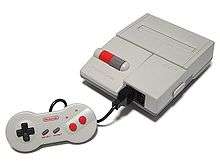
In December 1993, the Famicom received a similar redesign. It also loads cartridges through a covered slot on the top of the unit and uses non-hardwired controllers. Because HVC-101 uses composite video output instead of being RF only like the HVC-001, Nintendo marketed the newer model as the AV Famicom.[lower-alpha 4] Since the new controllers don't have microphones on them like the second controller on the original console, certain games such as the Disk System version of The Legend of Zelda and Raid on Bungeling Bay have certain tricks that cannot be replicated when played on an HVC-101 Famicom without a modified controller. In October 1987, Nintendo released a 3D stereoscopic headset called the Famicom 3D System (HVC-031) in Japan only.
Design flaws
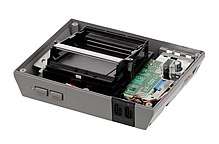
Nintendo's design styling for US release was made deliberately different from that of other game consoles. Nintendo wanted to distinguish its product from those of competitors and to avoid the generally poor reputation that game consoles had acquired following the North American video game crash of 1983. One result of this philosophy is to disguise the cartridge slot design as a front-loading zero insertion force (ZIF) cartridge socket, designed to resemble the front-loading mechanism of a VCR. The newly designed connector works quite well when both the connector and the cartridges are clean and the pins on the connector are new. Unfortunately, the ZIF connector is not truly zero insertion force. When a user inserts the cartridge into the NES, the force of pressing the cartridge down and into place bends the contact pins slightly, as well as pressing the cartridge's ROM board back into the cartridge itself. Frequent insertion and removal of cartridges cause the pins to wear out from repeated usage over the years and the ZIF design prove more prone to interference by dirt and dust than an industry-standard card edge connector.[41] These design issues are exacerbated by Nintendo's choice of materials; the console slot nickel connector springs wear due to design and the game cartridge's brass plated nickel connectors are also prone to tarnishing and oxidation. Nintendo sought to fix these issues by redesigning the next generation Super Nintendo Entertainment System (SNES) as a top loader similar to the Famicom to ensure better results reading the game cartridges.[42] Many players try to alleviate issues in the game caused by this corrosion by blowing into the cartridges, then reinserting them, which actually speeds up the tarnishing due to moisture. One way to slow down the tarnishing process and extend the life of the cartridges is to use isopropyl alcohol and swabs, as well as non-conductive metal polish such as Brasso or Sheila Shine.[43][44]
Lockout
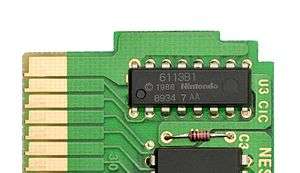
The Famicom as released in Japan contains no lockout hardware, which led to unlicensed cartridges (both legitimate and bootleg) becoming extremely common throughout Japan and East Asia.[45] The original NES contains the 10NES lockout chip, which prevents it from running cartridges unapproved by Nintendo. The top-loading NES-101 model released in 1993 does not use this chip or any other lockout device.
Initially, the 10NES chip proved a significant barrier to unlicensed developers seeking to develop and sell games for the console. However, hobbyists in later years discovered that disassembling the NES and cutting the fourth pin of the lockout chip would change the chip's mode of operation from "lock" to "key", removing all effects and greatly improving the console's ability to play legal games, as well as bootlegs and converted imports.
NES consoles sold in different regions have different lockout chips, so games marketed in one region do not work on consoles from another region. Known regions are these: USA/Canada (3193 lockout chip); most of Europe, Korea, and countries where Nintendo of Europe were responsible for distribution (3195); Asia and Hong Kong (3196); and UK, Italy, and Australia (3197). Because two types of lockout chip were released in Europe, European NES game boxes often have an "A" or "B" letter on the front, indicating whether the game is compatible with UK/Italian/Australian consoles (A), or the rest of Europe (B). Games in the rest of Europe typically have text on the box stating "This game is not compatible with the Mattel or NES versions of the Nintendo Entertainment System". Similarly, most UK/Italy/Australia games state "This game is only compatible with the Mattel or NES versions of the Nintendo Entertainment System".
Problems with the 10NES lockout chip frequently result in one of the console's most common issues: the blinking red power light, in which the system appears to turn itself on and off repeatedly because the 10NES would reset the console once per second. The lockout chip required constant communication with the chip in the game to work.[32]:247 Dirty, aging, and bent connectors often disrupt the communication, resulting in the blink effect.[41] In other cases, the console turns on but only displays a solid white, gray, or green screen.
Users have attempted to solve these problem by blowing air onto the cartridge connectors, inserting the cartridge just far enough to get the ZIF to lower, licking the edge connector, slapping the side of the system after inserting a cartridge, shifting the cartridge from side to side after insertion, pushing the ZIF up and down repeatedly, holding the ZIF down lower than it should have been, and cleaning the connectors with alcohol. Many frequently used methods to fix this problem actually risk damaging gaming cartridges or the system.[46] In 1989, Nintendo released an official NES Cleaning Kit to help users clean malfunctioning cartridges and consoles.
With the release of the top-loading NES-101 (NES 2) toward the end of the NES's lifespan, Nintendo resolved the problems by switching to a standard card edge connector and eliminating the lockout chip. All of the Famicom systems use standard card edge connectors, as do Nintendo's two subsequent game consoles, the Super Nintendo Entertainment System and the Nintendo 64.
In response to these hardware flaws, "Nintendo Authorized Repair Centers" sprang up across the U.S. According to Nintendo, the authorization program was designed to ensure that the machines were properly repaired. Nintendo would ship the necessary replacement parts only to shops that had enrolled in the authorization program. In practice, the authorization process consisted of nothing more than paying a fee to Nintendo for the privilege of stocking such parts.
Famicom 3D System
Nintendo released a stereoscopic headset peripheral called Famicom 3D System. This was never released outside Japan, since it was a commercial failure, making some gamers experience headaches and nausea.[47]
Famicom Modem
Nintendo released a modem peripheral called Famicom Modem. This was not intended for traditional games but for gambling on real horse races, stock trading, and banking.
Technical specifications
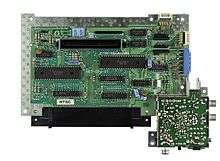
For its CPU, the NES uses the Ricoh 2A03, an 8-bit microprocessor containing a second source MOS Technology 6502 core, running at 1.79 MHz for the NTSC NES and 1.66 MHz for the PAL version.
The NES contains 2 kB of onboard work RAM.[48] A game cartridge may contain expanded RAM to increase this amount. The sizes of NES games vary from 8 kB (Galaxian) to 1 MB (Metal Slader Glory), but 128 to 384 kB is the most common.
The NES[49] uses a custom-made Picture Processing Unit (PPU) developed by Ricoh. All variations of the PPU feature 2 kB of video RAM, 256 bytes of on-die "object attribute memory" (OAM) to store the positions, colors, and tile indices of up to 64 sprites on the screen, and 28 bytes of on-die palette RAM to allow selection of background and sprite colors. The console's 2 kB of onboard RAM may be used for tile maps and attributes on the NES board and 8 kB of tile pattern ROM or RAM may be included on a cartridge. The system has an available color palette of 48 colors and 6 grays. Up to 25 simultaneous colors may be used without writing new values mid-frame: a background color, four sets of three tile colors, and four sets of three sprite colors. The NES palette is based on NTSC rather than RGB values. A total of 64 sprites may be displayed onscreen at a given time without reloading sprites mid-screen. The standard display resolution of the NES is 256 horizontal pixels by 240 vertical pixels.
Video output connections vary between console models. The original HVC-001 model of the Family Computer features only radio frequency (RF) modulator output. The North American and European consoles have support for composite video through RCA connectors in addition to the RF modulator. The HVC-101 model of the Famicom omits the RF modulator entirely and has composite video output via a proprietary 12-pin "multi-out" connector first introduced on the Super Famicom and Super Nintendo Entertainment System. Conversely, the North American re-released NES-101 model most closely resembles the original HVC-001 model Famicom, in that it features RF modulator output only.[50] Finally, the PlayChoice-10 utilizes an inverted RGB video output.
The stock NES supports a total of five sound channels, two of which are pulse channels with 4 pulse width settings, one is a triangle wave generator, another is a noise generator (often used for percussion), and the fifth one plays low-quality digital samples.
The NES supports expansion chips contained in certain cartridges to add sound channels and help with data processing. Developers can add these chips to their games, such as the Konami VRC6, Konami VRC7, Sunsoft 5B, Namco 163, and two more by Nintendo itself: the Nintendo FDS wave generator (a modified Ricoh RP2C33 chip with single-cycle wave table-lookup sound support), and the Nintendo Memory Management Controller 5 (MMC5).[51] Due to wiring differences between the Famicom and NES, a stock NES console is incapable of passing through audio generated by expansion chips utilizing additional sound channels, but can be modified to regain this capability.[52][53]
Accessories
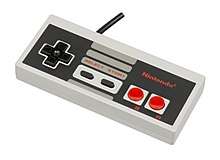
Controllers
The game controller used for both the NES and the Famicom features an oblong brick-like design with a simple four button layout: two round buttons labeled "A" and "B", a "START" button, and a "SELECT" button.[54] Additionally, the controllers utilize the cross-shaped joypad, designed by Nintendo employee Gunpei Yokoi for Nintendo Game & Watch systems, to replace the bulkier joysticks on earlier gaming consoles' controllers.[19]:279
The original model Famicom features two game controllers, both of which are hardwired to the back of the console. The second controller lacks the START and SELECT buttons, but features a small microphone. Relatively few games use this feature. The earliest produced Famicom units have square A and B buttons.[50] This was changed to the circular designs because of the square buttons being caught in the controller casing when pressed down and glitches within the hardware causing the system to freeze occasionally while playing a game.
Instead of the Famicom's hardwired controllers, the NES features two custom 7-pin ports on the front of the console to support swappable and potentially third-party controllers. The controllers bundled with the NES are identical and include the START and SELECT buttons, allowing some NES versions of games, such as The Legend of Zelda, to use the START button on the second controller to save the game at any time. The NES controllers lack the microphone, which is used on the Famicom version of Zelda to kill certain enemies, or for singing with karaoke games.[39]
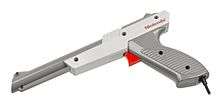
A number of special controllers are for use with specific games, though are not commonly utilized. Such devices include the Zapper light gun, the R.O.B.,[19]:297 and the Power Pad.[32]:226[55] The original Famicom features a deepened DA-15 expansion port on the front of the unit, which is used to connect most auxiliary devices.[39] On the NES, these special controllers are generally connected to one of the two control ports on the front of the console.
Nintendo made two advanced controllers for the NES called NES Advantage and the NES Max. Both controllers have a Turbo feature, where one press of the button represents multiple automatic rapid presses. This feature allows players to shoot much faster in shooter games. The NES Advantage has two knobs that adjust the firing rate of the turbo button from quick to Turbo, as well as a "Slow" button that slows down compatible games by rapidly pausing the game. The NES Max has a non-adjustable Turbo feature and no "Slow" feature, and has a wing-like handheld shape and a sleek directional pad. Turbo functionality exists on the NES Satellite, the NES Four Score, and the U-Force. Other accessories include the Power Pad and the Power Glove, which is featured in the movie The Wizard.
Near the end of the NES's lifespan, upon the release of the AV Famicom and the top-loading NES 2, the design of the game controllers was modified slightly. Though the original button layout was retained, the controller's shape resembles that of the SNES's controller. In addition, the AV Famicom dropped the hardwired controllers in favor of detachable controller ports. The controllers included with the Famicom AV have 90 cm (3 feet) long cables, compared to the 180 cm (6 feet) of NES controllers.[56]
The original NES controller has become one of the most recognizable symbols of the console. Nintendo has mimicked the look of the controller in several other products, from promotional merchandise to limited edition versions of the Game Boy Advance.[57]
Japanese accessories
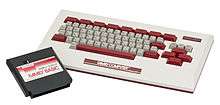
Few of the numerous peripheral devices and software packages for the Famicom were released outside Japan.
Family BASIC is an implementation of BASIC for the Famicom, packaged with a keyboard. Similar in concept to the Atari 2600 BASIC cartridge, it allows the user to write programs, especially games, which can be saved on an included cassette recorder.[58] Nintendo of America rejected releasing Famicom BASIC in the US because it did not think it fit their primary marketing demographic of children.[32]:162
The Famicom Modem connected a Famicom to a now defunct proprietary network in Japan which provided content such as financial services.[59] A dialup modem was never released for NES.
Family Computer Disk System
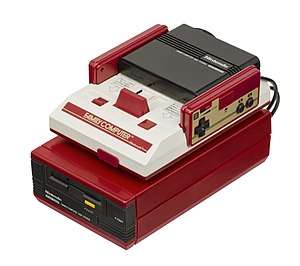
In 1986, Nintendo released the Famicom Disk System (FDS) in Japan, a type of floppy drive that uses a single-sided, proprietary 5 cm (2") disk and plugs into the cartridge port. It contains RAM for the game to load into and an extra single-cycle wave table-lookup sound chip. The disks are used both for storing the game and saving progress, with a total capacity of 128k (64k per side). The disks were originally obtained from kiosks in malls and other public places where buyers could select a game and have it written to the disk. This process cost less than cartridges and users could take the disk back to a vending booth and have it rewritten with a new game, or the high score faxed to Nintendo for national leaderboard contests.
A variety of games for the FDS were released by Nintendo (including some which had already been released on cartridge, such as Super Mario Bros.), and third party companies such as Konami, Taito, or unlicensed publishers. Its limitations became quickly apparent as larger ROM chips were introduced, allowing cartridges with greater than 128k of space. More advanced memory management chips (MMC) soon appeared and the FDS quickly became obsolete. Nintendo also charged developers high prices to produce FDS games, and many refused to develop for it, instead continuing to make cartridge games. After only two years, the FDS was discontinued, although vending booths remained in place until 1993 and Nintendo continued to service drives, and to rewrite and offer replacement disks until 2003. Approximately four million drives were sold.
Nintendo did not release the Disk System outside Japan due to numerous problems encountered with the medium in Japan, and due to the increasing data storage capacity and reducing cost of the highly reliable cartridge medium.[60] As a result, many Disk System games such as Castlevania, The Legend of Zelda, and Bubble Bobble were converted to cartridge format for their export releases, resulting in simplified sound and the disk save function replaced by either password or battery save systems.
Hardware clones
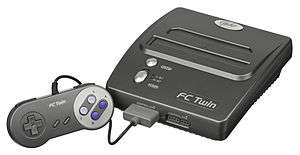
A thriving market of unlicensed NES hardware clones emerged during the climax of the console's popularity. Initially, such clones were popular in markets where Nintendo issued a legitimate version of the console long time after unlicensed hardware. In particular, the Dendy (Russian: Де́нди), an unlicensed hardware clone produced in Taiwan and sold in the former Soviet Union, emerged as the most popular video game console of its time in that setting and it enjoyed a degree of fame roughly equivalent to that experienced by the NES/Famicom in North America and Japan. A range of Famicom clones was marketed in Argentina during the late 1980s and early 1990s under the name of "Family Game", resembling the original hardware design. The Micro Genius (Simplified Chinese: 小天才) was marketed in Southeast Asia as an alternative to the Famicom; and in Central Europe, especially Poland, the Pegasus was available.[61] Since 1989, there were many Brazilian clones of NES,[35] and the very popular Phantom System (with hardware superior to the original console) caught the attention of Nintendo itself.[34]

The unlicensed clone market has flourished following Nintendo's discontinuation of the NES. Some of the more exotic of these resulting systems surpass the functionality of the original hardware, such as a portable system with a color LCD (PocketFami). Others have been produced for certain specialized markets, such as a rather primitive personal computer with a keyboard and basic word processing software.[62] These unauthorized clones have been helped by the invention of the so-called NES-on-a-chip.[63]
As was the case with unlicensed games, Nintendo has typically gone to the courts to prohibit the manufacture and sale of unlicensed cloned hardware. Many of the clone vendors have included built-in copies of licensed Nintendo software, which constitutes copyright infringement in most countries.
Although most hardware clones were not produced under license by Nintendo, certain companies were granted licenses to produce NES-compatible devices. The Sharp Corporation produced at least two such clones: the Twin Famicom and the SHARP 19SC111 television. The Twin Famicom is compatible with both Famicom cartridges and Famicom Disk System disks.[64]:29 Like the Famicom, it is red and black and has hardwired controllers, but has a different case design. The SHARP 19SC111 television includes a built-in Famicom.[65] A similar licensing deal was reached with Hyundai Electronics, who licensed the system under the name Comboy in the South Korean market. This deal with Hyundai was made necessary because of the South Korean government's wide ban on all Japanese "cultural products", which remained in effect until 1998 and ensured that the only way Japanese products could legally enter the South Korean market was through licensing to a third-party (non-Japanese) distributor (see also Japan–Korea disputes).[66] In India, the system was sold under the name Samurai and assembled locally under license from kits due to policies that banned imports of electronics.[67]
NES Test Station
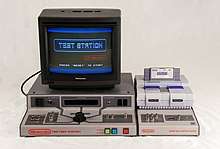

The NES Test Station diagnostics machine was introduced in 1988. It is a NES-based unit designed for testing NES hardware, components, and games. It was only provided for use in World of Nintendo boutiques as part of the Nintendo World Class Service program. Visitors were to bring items to test with the station, and could be assisted by a store technician or employee.
The NES Test Station's front features a Game Pak slot and connectors for testing various components (AC adapter, RF switch, Audio/Video cable, NES Control Deck, accessories and games), with a centrally-located selector knob to choose which component to test. The unit itself weighs approximately 11.7 pounds without a TV. It connects to a television via a combined A/V and RF Switch cable. By actuating the green button, a user can toggle between an A/V Cable or RF Switch connection. The television it is connected to (typically 11" to 14") is meant to be placed atop it.[68]
In 1991, Nintendo provided an add-on called the "Super NES Counter Tester" that tests Super Nintendo components and games. The SNES Counter Tester is a standard SNES on a metal fixture with the connection from the back of the SNES re-routed to the front of the unit. These connections may be made directly to the test station or to the TV, depending on what is to be tested.
Games
The Nintendo Entertainment System has a number of groundbreaking games. Super Mario Bros. pioneered side-scrollers whilst The Legend of Zelda established the genre of action adventure games, and helped popularize battery-backed save functionality. A third influential game is Metroid, a game that established the Metroidvania genre.
Game Pak
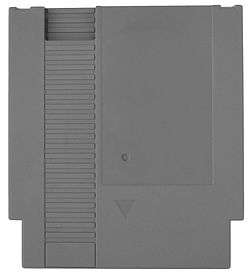
The NES uses a 72-pin design, as compared with 60 pins on the Famicom. To reduce costs and inventory, some early games released in North America are simply Famicom cartridges attached to an adapter to fit inside the NES hardware.[26] Early NES cartridges are held together with five small slotted screws. Games released after 1987 were redesigned slightly to incorporate two plastic clips molded into the plastic itself, removing the need for the top two screws.[69]
The back of the cartridge bears a label with handling instructions. Production and software revision codes were imprinted as stamps on the back label to correspond with the software version and producer. All licensed NTSC and PAL cartridges are a standard shade of gray plastic, with the exception of The Legend of Zelda and Zelda II: The Adventure of Link, which were manufactured in gold-plastic carts. Unlicensed carts were produced in black, robin egg blue, and gold, and are all slightly different shapes than standard NES cartridges. Nintendo also produced yellow-plastic carts for internal use at Nintendo Service Centers, although these "test carts" were never made available for purchase. All licensed US cartridges were made by Nintendo, Konami, and Acclaim. For promotion of DuckTales: Remastered, Capcom sent 150 limited-edition gold NES cartridges with the original game, featuring the Remastered art as the sticker, to different gaming news agencies. The instruction label on the back includes the opening lyric from the show's theme song, "Life is like a hurricane".[70]
Famicom cartridges are shaped slightly differently. Unlike NES games, official Famicom cartridges were produced in many colors of plastic. Adapters, similar in design to the popular accessory Game Genie, are available that allow Famicom games to be played on an NES. In Japan, several companies manufactured the cartridges for the Famicom.[32]:61 This allowed these companies to develop their own customized chips designed for specific purposes, such as superior sound and graphics.
Third-party licensing

Nintendo's near monopoly on the home video game market left it with a dominant influence over the industry. Unlike Atari, which never actively pursued third-party developers (and even went to court in an attempt to force Activision to cease production of Atari 2600 games), Nintendo had anticipated and encouraged the involvement of third-party software developers, though strictly on Nintendo's terms.[71] Some of the Nintendo platform-control measures were adopted in a less stringent way by later console manufacturers such as Sega, Sony, and Microsoft.
To this end, a 10NES authentication chip is in every console and in every officially licensed cartridge. If the console's chip can not detect a counterpart chip inside the cartridge, the game does not load.[32]:247 Nintendo portrayed these measures as intended to protect the public against poor-quality games,[72] and placed a golden seal of approval on all licensed games released for the system.
Nintendo found success with Japanese arcade manufacturers such as Konami, Capcom, Taito and Namco, which signed on as third-party developers. However, they found resistance with US game developers including Atari, Activision, Electronic Arts and Epyx refusing Nintendo's one-sided terms. Acclaim Entertainment, a fledgling game publisher founded by former Activision employees, would be the first major third-party licensee based out of the United States to sign on with Nintendo in late 1987. Atari (through Tengen) and Activision would sign on soon after.
Nintendo was not as restrictive as Sega, which did not permit third-party publishing until Mediagenic in late summer 1988.[73] Nintendo's intention was to reserve a large part of NES game revenue for itself. Nintendo required that it be the sole manufacturer of all cartridges, and that the publisher had to pay in full before the cartridges for that game be produced. Cartridges could not be returned to Nintendo, so publishers assumed all the risk. As a result, some publishers lost more money due to distress sales of remaining inventory at the end of the NES era than they ever earned in profits from sales of the games. Because Nintendo controlled the production of all cartridges, it was able to enforce strict rules on its third-party developers, which were required to sign a contract by Nintendo that would obligate these parties to develop exclusively for the system, order at least 10,000 cartridges, and only make five games per year.[32]:214–215 The global 1988 shortage of DRAM and ROM chips reportedly caused Nintendo to only permit an average of 25% of publishers' requests for cartridges, with some receiving much higher amounts and others almost none.[72] GameSpy noted that Nintendo's "iron-clad terms" made the company many enemies during the 1980s. Some developers tried to circumvent the five game limit by creating additional company brands like Konami's Ultra Games label and others tried circumventing the 10NES chip.[71]
Nintendo was accused of antitrust behavior because of the strict licensing requirements.[74] The United States Department of Justice and several states began probing Nintendo's business practices, leading to the involvement of Congress and the Federal Trade Commission (FTC). The FTC conducted an extensive investigation which included interviewing hundreds of retailers. During the FTC probe, Nintendo changed the terms of its publisher licensing agreements to eliminate the two-year rule and other restrictive terms. Nintendo and the FTC settled the case in April 1991, with Nintendo required to send vouchers giving a $5 discount off to a new game, to every person that had purchased a NES game between June 1988 and December 1990. GameSpy remarked that Nintendo's punishment was particularly weak giving the case's findings, although it has been speculated that the FTC did not want to damage the video game industry in the United States.[71]
With the NES near the end of its life, many third-party publishers such as Electronic Arts supported upstart competing consoles with less strict licensing terms such as the Sega Genesis and then the PlayStation, which eroded and then took over Nintendo's dominance in the home console market, respectively. Consoles from Nintendo's rivals in the post-SNES era had always enjoyed much stronger third-party support than Nintendo, which relied more heavily on first-party games.
Unlicensed games
Companies that refused to pay the licensing fee or were rejected by Nintendo found ways to circumvent the console's authentication system. Most of these companies created circuits that use a voltage spike to temporarily disable the 10NES chip.[32]:286 A few unlicensed games released in Europe and Australia are in the form of a dongle to connect to a licensed game, in order to use the licensed game's 10NES chip for authentication. To combat unlicensed games, Nintendo of America threatened retailers who sold them with losing their supply of licensed games, and multiple revisions were made to the NES PCBs to prevent unlicensed games from working.
Atari Games took a different approach with its line of NES products, Tengen. The company attempted to reverse engineer the lockout chip to develop its own "Rabbit" chip. Tengen also obtained a description of the lockout chip from the United States Patent and Trademark Office by falsely claiming that it was required to defend against present infringement claims. Nintendo successfully sued Tengen for copyright infringement. Tengen's antitrust claims against Nintendo were never decided.[74]
Color Dreams made Christian video games under the subsidiary name Wisdom Tree. Historian Steven Kent wrote, "Wisdom Tree presented Nintendo with a prickly situation. The general public did not seem to pay close attention to the court battle with Atari Games, and industry analysts were impressed with Nintendo's legal acumen; but going after a tiny company that published innocuous religious games was another story."[19]:400
Game rentals
As the Nintendo Entertainment System grew in popularity and entered millions of American homes, some small video rental shops began buying their own copies of NES games, and renting them out to customers for around the same price as a video cassette rental for a few days. Nintendo received no profit from the practice beyond the initial cost of their game, and unlike movie rentals, a newly released game could hit store shelves and be available for rent on the same day. Nintendo took steps to stop game rentals, but didn't take any formal legal action until Blockbuster Video began to make game rentals a large-scale service. Nintendo claimed that allowing customers to rent games would significantly hurt sales and drive up the cost of games.[75] Nintendo lost the lawsuit,[76] but did win on a claim of copyright infringement.[77] Blockbuster was banned from including original, copyrighted instruction booklets with its rented games. In compliance with the ruling, Blockbuster produced original short instructions—usually in the form of a small booklet, card, or label stuck on the back of the rental box—that explained the game's basic premise and controls. Video rental shops continued the practice of renting video games.
Reception
By 1988, industry observers stated that the NES's popularity had grown so quickly that the market for Nintendo cartridges was larger than that for all home computer software.[78][19]:347 Compute! reported in 1989 that Nintendo had sold seven million NES systems in 1988 alone, almost as many as the number of Commodore 64s sold in its first five years.[79] "Computer game makers [are] scared stiff", the magazine said, stating that Nintendo's popularity caused most competitors to have poor sales during the previous Christmas and resulted in serious financial problems for some.[80]
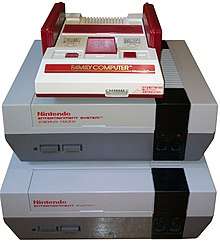
In June 1989, Nintendo of America's vice president of marketing Peter Main, said that the Famicom was present in 37% of Japan's households.[81] By 1990, 30% of American households owned the NES, compared to 23% for all personal computers.[82] By 1990, the NES had outsold all previously released consoles worldwide.[83] The slogan for this brand was "It can't be beaten".[32]:345 The Nintendo Entertainment System was not available in the Soviet Union.
In the early 1990s, gamers predicted that competition from technologically superior systems such as the 16-bit Sega Genesis would mean the immediate end of the NES's dominance. Instead, during the first year of Nintendo's successor console the Super Famicom (named Super Nintendo Entertainment System outside Japan), the Famicom remained the second highest-selling video game console in Japan, outselling the newer and more powerful NEC PC Engine and Sega Mega Drive by a wide margin.[84] The launch of the Genesis was overshadowed by the launch of Super Mario Bros. 3 for NES. The console remained popular in Japan and North America until late 1993, when the demand for new NES software abruptly plummeted.[84] The final licensed Famicom game released in Japan is Takahashi Meijin no Bōken Jima IV (Adventure Island IV), in North America is Wario's Woods, and in Europe is The Lion King in 1995.[85] In the wake of ever decreasing sales and the lack of new games, Nintendo of America officially discontinued the NES by 1995.[4][86] Nintendo produced new Famicom units in Japan until September 25, 2003,[87] and continued to repair Famicom consoles until October 31, 2007, attributing the discontinuation of support to insufficient supplies of parts.[88][89]
Legacy
The NES was released two years after the North American video game crash of 1983, when many retailers and adult consumers regarded electronic games as a passing fad,[19]:280 so many believed at first that the NES would soon fade.[80] Before the NES and Famicom, Nintendo was known as a moderately successful Japanese toy and playing card manufacturer, but the consoles' popularity helped the company grow into an internationally recognized name almost synonymous with video games as Atari had been,[90] and set the stage for Japanese dominance of the video game industry.[91] With the NES, Nintendo also changed the relationship between console manufacturers and third-party software developers by restricting developers from publishing and distributing software without licensed approval. This led to higher-quality games, which helped change the attitude of a public that had grown weary from poorly produced games for earlier systems.[19]:306–307
The NES hardware design is also very influential. Nintendo chose the name "Nintendo Entertainment System" for the US market and redesigned the system so it would not give the appearance of a child's toy. The front-loading cartridge input allow it to be used more easily in a TV stand with other entertainment devices, such as a videocassette recorder.[92][93][94]
The system's hardware limitations led to design principles that still influence the development of modern video games. Many prominent game franchises originated on the NES, including Nintendo's own Super Mario Bros.,[64]|:57 The Legend of Zelda[19]:353 and Metroid,[19]:357 Capcom's Mega Man[95] franchise, Konami's Castlevania[19]:358 franchise, Square's Final Fantasy,[64]|:95 and Enix's Dragon Quest[64]|:222 franchises.
NES imagery, especially its controller, has become a popular motif for a variety of products,[96][97][98][99] including Nintendo's own Game Boy Advance.[57] Clothing, accessories, and food items adorned with NES-themed imagery are still produced and sold in stores.
Emulation
The NES can be emulated on many other systems. The first emulator was the Japanese-only Pasofami. It was soon followed by iNES, which is available in English and is cross-platform, in 1996. It was described as being the first NES emulation software that could be used by a non-expert.[100] NESticle, a popular MS-DOS-based emulator, was released on April 3, 1997. Nintendo offers officially licensed emulation of many specific NES games via its own Virtual Console for the Wii, Nintendo 3DS, and Wii U, and the Nintendo Switch Online service.
Re-release
On July 14, 2016, Nintendo announced the November 2016 launch of a miniature replica of the NES, named the Nintendo Entertainment System: NES Classic Edition in the United States and Nintendo Classic Mini: Nintendo Entertainment System in Europe and Australia.[101] The emulation-based console includes 30 permanently inbuilt games from the vintage NES library, including the Super Mario Bros. and The Legend of Zelda series. The system features HDMI display output and a new replica controller, which can also connect to the Wii Remote for use with Virtual Console games.[102][103] It was discontinued in North America on April 13, 2017, and worldwide on April 15, 2017. However, Nintendo announced in September 2017 that the NES Classic Mini would return to production on June 29, 2018, only to be discontinued again permanently by December of that year.[104][105]
See also
- History of Nintendo
- Nintendo Hard
- Nintendo World Championships
Notes
^ a: For distribution purposes, most of Europe and Australasia were divided into two regions by Nintendo. The first of these regions consisted of mainland Europe (excluding Italy) and Scandanavia, which saw the NES in 1987 and 1986 respectively. The console was released in the second region, consisting of the United Kingdom (and Ireland), Italy, and Australia (and New Zealand), in 1987.
^ b: In Japan, Nintendo sold an optional expansion peripheral for the Famicom, called the Famicom Disk System, which enables the console to run software from proprietary floppy disks.
^ c: The original Famicom features two hardwired game controllers and a single port for additional input devices. See game controllers section.
^ e: The NES is the overall best-selling system worldwide of its time. In Japan and the United States, it controlled 85-90% of the market.[32]:349 In Europe, it was at most in 10-12% of households.[32]:413–414 Nintendo sold 61.9 million NES units worldwide: 19.35 million in Japan, 34 million in the Americas, and 8.5 million in other regions.[7]
^ f: The commonly bundled game Super Mario Bros. popularized the platform game genre and introduced elements that would be copied in many subsequent games[106]
^ g: Atari broke off negotiations with Nintendo in response to Coleco's unveiling of an unlicensed port of Donkey Kong for its Coleco Adam computer system. Although the game had been produced without Nintendo's permission or support, Atari took its release as a sign that Nintendo was dealing with one of its major competitors in the market.[19]:283–285
^ h: Donkey Kong Jr. Math and Mach Rider are often erroneously listed as launch games. Neither was available until later in 1986.[25]
References
- "Oct. 18, 1985: Nintendo Entertainment System Launches". WIRED. October 18, 2010. Retrieved June 11, 2015.
- "Nintendo Co., Ltd. : Consolidated Sales Transition by Region" (PDF). Nintendo.co.jp. Retrieved August 8, 2018.
- Levin, Martin (November 20, 1985). "New components add some Zap to video games". San Bernardino County Sun. p. A-4.
- "Nintendo Entertainment System (NES) – 1985–1995". Classic Gaming. GameSpy. Archived from the original on October 29, 2012. Retrieved December 20, 2019.
- L'Histoire de Nintendo volume 3 p. 113 (Ed. Pix'n Love, 2011)
- Nintendo to end Famicom and Super Famicom production. GameSpot.com (May 30, 2003). Retrieved on August 23, 2013.
- "Consolidated Sales Transition by Region" (PDF). First console by Nintendo. January 27, 2010. Archived from the original (PDF) on February 14, 2010. Retrieved February 14, 2010.
- Stuart, Keith (September 13, 2010). "Super Mario Bros: 25 Mario facts for the 25th anniversary". the Guardian. Retrieved November 2, 2018.
- "Super Mario Bros voted greatest computer game ever". The Daily Telegraph. July 27, 2008. Retrieved July 22, 2010.
- Goss, Patrick. "The games that sold consoles". MSN. Archived from the original on March 9, 2008. Retrieved September 24, 2011.
- Consalvo, Mia (2006). "Console video games and global corporations: Creating a hybrid culture". New Media & Society. 8 (1): 117–137. doi:10.1177/1461444806059921.(subscription required)
- Sanchez-Crespo, Daniel (September 8, 2003). Core Techniques and Algorithms in Game Programming. New Riders Games. p. 14. ISBN 0-13-102009-9.
- "How Nintendo Made The NES (And Why They Gave It A Gun)". Kotaku. October 16, 2015. Archived from the original on October 16, 2015.
- "7 things I learned from the designer of the NES". The Verge. October 18, 2015. Archived from the original on October 19, 2015.
- 高野, 雅晴 (January 16, 1995). "ファミコン開発物語". 日経エレクトロニクス (in Japanese). Nikkei Business Publications. OCLC 5530170. Retrieved June 6, 2019 – via Nikkei Trendy Net.
- 高野, 雅晴 (January 16, 1995). "ファミコン開発物語". 日経エレクトロニクス (in Japanese). Nikkei Business Publications. OCLC 5530170. Retrieved June 7, 2019 – via Nikkei Trendy Net.
- "GlitterBerri's Game Translations » Deciding on the Specs". Glitterberri.com.
- GlitterBerri's Game Translations » Synonymous With the Domestic Game Console. Glitterberri.com (April 21, 2012). Retrieved on August 23, 2013.
- Kent, Steven L. (2001). The Ultimate History of Video Games: The Story Behind the Craze that Touched our Lives and Changed the World. Roseville, California: Prima Publishing. ISBN 0-7615-3643-4.
- "Nintendo's Final Solution". Electronic Games. Vol. 4 no. 36. March 1985. p. 9. Retrieved February 5, 2012.
- Chad Margetts & M. Noah Ward (May 31, 2005). "Lance Barr Interview". Nintendojo. Retrieved June 19, 2016.
- O'Kane, Sean (October 18, 2015). "7 things I learned from the designer of the NES". The Verge. Retrieved September 21, 2018.
- The reasons for NES' Western design, explained by its main developer. Vandal.net, 29 February 2020
- Burnham, Van (2001). Supercade: A Visual History of the Videogame Age, 1971–1984. Cambridge, Massachusetts: MIT Press. p. 375. ISBN 0-262-52420-1.
- Dayton, David (October 18, 2010). "Super Mario's Release Date is Missing!". The Mushroom Kingdom. Retrieved October 8, 2011.
- Edwards, Benj (November 14, 2005). "How to Tell if a Copy of Gyromite has a Famicom Adapter in it". Vintage Computing and Gaming. Retrieved October 20, 2008.
- "NES". Icons. Season 4. Episode 5010. December 1, 2005. G4. Archived from the original on October 16, 2012.
- "25 Smartest Moments in Gaming". GameSpy. July 21–25, 2003. p. 22. Archived from the original on September 2, 2012.
- Cunningham, Andrew (July 15, 2013). "The NES turns 30: How it began, worked, and saved an industry". Ars Technica. Retrieved September 21, 2018.
- Boyer, Steven. "A Virtual Failure: Evaluating the Success of Nintendos Virtual Boy." Velvet Light Trap.64 (2009): 23–33. ProQuest Research Library. Web. May 24, 2012.
- "Computerspel komt terug". Krantenbankzeeland.nl. November 11, 1988. Retrieved October 26, 2017.
- Sheff, David (1993). Game Over. New York: Random House. ISBN 0-679-40469-4. Retrieved July 2, 2019.
- Barboni, Flavio (July 13, 2013). "Master System x NES" (in Portuguese). TechTudo.
- "Playtronic, a história" [Playtronic, the history] (in Portuguese). Nintendopedia Brasilis. 2018.
- Noviello, Renato (2000). "O NES no Brasil" [The NES in Brazil] (in Portuguese). The Nes Archive. Archived from the original on September 22, 2018. Retrieved July 8, 2018.
- Brooks, Andree (May 4, 1991). "Picking Out a Home Video Game System". New York Times. Retrieved June 29, 2010.
- Andrew Cunningham (July 15, 2013). "The NES Turns 30: How It Began, Worked, and Saved an Industry". Ars Technica. Retrieved October 17, 2015.
- (1996, December). Nintendo Power, Volume 91, Page 107.
- Edwards, Benj (August 7, 2008). "Inside Nintendo's Classic Game Console". PC World. Archived from the original on July 2, 2010. Retrieved June 23, 2010.
- "Guru Larry's Retrospective on the regional variations and releases of the European Nintendo Entertainment System". Blisteredthumbs.net. Archived from the original on September 27, 2012. Retrieved October 2, 2012.
- Edwards, Benj (November 7, 2005). "No More Blinkies: Replacing the NES's 72-Pin Cartridge Connector". Vintage Computing and Gaming. Retrieved June 3, 2007.
- Nelson, Rob (February 12, 2003). "Nintendo Redivivus: how to resuscitate an old friend". Ars Technica. Retrieved June 3, 2007.
- Higgins, Chris. "Did Blowing into Nintendo Cartridges Really Help?". Mental Floss, Inc. Retrieved August 6, 2014.
- Hill, Kyle (July 1, 2014). "We Blow Into Video Game Cartridges Because of Weird Psychology". Retrieved August 6, 2014.
- Ramirez, Anthony (December 21, 1989). "The Games Played For Nintendo's Sales". The New York Times. Retrieved June 28, 2010.
- "Did Blowing into Nintendo Cartridges Really Help?". MentalFloss. September 24, 2012. Retrieved July 12, 2018.
- "Five Famicom Peripherals That Never Escaped Japan | Science and Tech | The Escapist". v1.escapistmagazine.com. Retrieved February 25, 2020.
- Hongo, Jun (July 15, 2013). "Nintendo brought arcade games into homes 30 years ago". The Japan Times Online. ISSN 0447-5763. Retrieved August 1, 2018.
- "NES Specifications". Problemkaputt.de. Retrieved November 28, 2015.
- Nutt, Christian; Turner, Benjamin (2003). "Metal Storm: All About the Hardware". Nintendo Famicom—20 years of fun. Archived from the original on December 23, 2005. Retrieved May 21, 2006.
- "Sound hardware". Famitracker.com. Retrieved November 28, 2015.
- "Open Hidden Sound Channels in the NES". Retrofixes.com. Retrieved January 15, 2018.
- "NES Expanded Audio: 100k Pot Mod". Curriculumcrasher.com. Retrieved January 15, 2018.
- Nintendo Entertainment System Instruction Booklet. Nintendo. 1989. p. 5.
- Nutt, Christian; Turner, Benjamin (2003). "Metal Storm: All About the Hardware". Nintendo Famicom—20 years of fun. Archived from the original on May 20, 2009. Retrieved July 23, 2010.
- Edwards, Benj (February 23, 2006). "Gotta Love That Fresh "AV Famicom Smell"". Vintage Computing and Gaming. Retrieved July 1, 2010.
- Totilo, Stephen (June 3, 2004). "Revenge of Pac-Man: Vintage Games Are Back". New York Times. Retrieved July 24, 2016.
- Kohler, Chris (March 11, 2007). "VGL: Koji Kondo Interview". Wired.com. Condé Nast. Retrieved July 19, 2010.
- "Stock Link by Nintendo". New York Times. October 3, 1989. Retrieved June 30, 2010.
- Life, Nintendo (November 20, 2010). "Feature: Slipped Disk - The History of the Famicom Disk System". Nintendo Life. Retrieved July 12, 2018.
- Pegasus IQ-502 Polish review of the most popular NES / Famicom clone – Pegasus IQ-502
- Phillips, Ashley (August 7, 2008). "Researchers Propose $12 Computer for Developing Countries". ABC News. Retrieved July 19, 2010.
- Edwards, Benj (August 7, 2007). "VC&G Interview: Brian Parker on RetroZone and the PowerPak NES Flash Cart". Vintage Computing and Gaming. Retrieved July 21, 2010.
- Kohler, Chris (2004). Power-Up: How Japanese Video Games Gave the World an Extra Life. Indianapolis, Indiana: Brady Games. ISBN 0-7440-0424-1.
- Barnholt, Ray (April 7, 2010). "The Island of Lost Hardware: TVs With an NES Inside". Retronauts. 1Up. Archived from the original on October 19, 2012. Retrieved July 21, 2010.
- "Breaking the Ice: South Korea Lifts Ban on Japanese Culture". Trends in Japan. December 7, 1998. Retrieved May 19, 2007.
- "Nintendo Wii and DS to launch in India on September 30". Retrieved December 26, 2012.
- Mike. "Nintendo World Class Service | Nintendo Player". NintendoPlayer. Archived from the original on September 7, 2013. Retrieved September 5, 2013.
- "eBay Guides – What's a Five Screw Nintendo NES game 5 screw huh". Reviews.ebay.com. Retrieved October 20, 2008.
- Hilliard, Kyle (August 7, 2013). "Capcom's Golden DuckTales Promotional Cartridge Is Actually DuckTales". Game Informer. GameStop. Retrieved August 7, 2013.
- GameSpy.com – Article. Web.archive.org (March 20, 2008). Retrieved on August 23, 2013.
- Keizer, Gregg (September 1988). "Games Hot, but Cartridges Cool". Compute!. p. 8. Retrieved November 10, 2013.
- Kunkel, Bill; Worley, Joyce; Katz, Arnie (November 1988). "Video Gaming World". Computer Gaming World. p. 54.
- U.S. Court of Appeals; Federal Circuit (1992). "Atari Games Corp. v. Nintendo of America Inc". Digital Law Online. Retrieved March 30, 2005.
- The Morning Call – Article. Retrieved on August 26, 2013.
- 1UP.com – Article Archived October 17, 2013, at the Wayback Machine. Retrieved on August 26, 2013.
- SunSentinel – Article. Retrieved on August 26, 2013.
- "The Nintendo Threat?". Computer Gaming World. June 1988. p. 50.
- Ferrell, Keith (July 1989). "Just Kids' Play or Computer in Disguise?". Compute!. p. 28. Retrieved November 11, 2013.
- Keizer, Gregg (July 1989). "Editorial License". Compute!. p. 4. Retrieved November 11, 2013.
- Freitag, Michael (June 8, 1989). "Talking Deals; How Nintendo Can Help A.T.&T". International New York Times. ISSN 0362-4331. Retrieved February 7, 2015.
- "Fusion, Transfusion or Confusion / Future Directions In Computer Entertainment". Computer Gaming World. December 1990. p. 26.
- Nielsen, Martin (1997). "The Nintendo Entertainment System (NES) FAQ v3.0A". ClassicGaming.com's Museum. Archived from the original on October 6, 2008. Retrieved July 16, 2007.
- "International Outlook". Electronic Gaming Monthly (53). EGM Media, LLC. December 1993. pp. 96–98.
- Turner, Benjamin; Christian Nutt (July 18, 2003). "8-Bit Memories, 1988–1994". GameSpy.com. p. 27. Archived from the original on May 20, 2009. Retrieved June 30, 2010.
- "CES ProNews Flashes!". GamePro. No. 68. IDG. March 1995. p. 156.
[Nintendo vice president of marketing Peter] Main also officially announced that the die-hard NES platform has 'retired.'
- Hirohiko Niizumi (May 30, 2003). "Nintendo to end Famicom and Super Famicom production". GameSpot. Retrieved January 4, 2009.
- "Nintendo's classic Famicom faces end of road". AFP. October 31, 2007. Archived from the original on November 5, 2007. Retrieved November 9, 2007.
- 初代「ファミコン」など公式修理サポート終了. ITmedia News (in Japanese). ITmedia. October 16, 2007. Retrieved January 20, 2008.
- McGill, Douglas C. (December 4, 1988). "Nintendo Scores Big". New York Times. Retrieved July 1, 2010.
- "Smart Bomb: Inside the Video Game Industry". Talk of the Nation. November 14, 2005. National Public Radio.
- "Nintendo Wins Emmy Award" (Press release). Nintendo. July 16, 2007. Retrieved October 24, 2007.
- National Academy of Television Arts And Sciences. "Outstanding Achievement in Technical/Engineering Development Awards" (PDF). Archived from the original (PDF) on February 28, 2008.
- "Nintendo Wins Emmy For DS And Wii Engineering". News.sky.com. Retrieved October 2, 2012.
- Turner, Benjamin; Christian Nutt (July 18, 2003). "8-Bit Memories, 1988–1994". GameSpy.com. p. 20. Archived from the original on May 20, 2009. Retrieved June 30, 2010.
- "Retro NES USB Controller". Think Geek. Retrieved July 1, 2010.
- Edwards, Benj (August 19, 2007). "VC&G Review: Nintendo Power Mints". Vintage Computing and Gaming. Retrieved July 1, 2010.
- "Nintendo Controller Pop Art T-Shirt". Hot Topic. Retrieved July 1, 2010.
- "Special edition Nintendo Vans prove your inner nerd never died".
- Fayzullin, Marat "iNES". Retrieved on January 10, 2015.
- Biggs, Tim (July 15, 2016). "Nintendo announces mini NES console with 30 games included". The Sydney Morning Herald. Retrieved July 15, 2016.
- Kamen, Matt (July 14, 2016). "Nintendo unveils the Classic Mini loaded with 30 NES games". Retrieved July 14, 2016.
- Paul, Ian (July 14, 2016). "Nintendo's releasing a miniature NES console packed with 30 classic games". Retrieved July 14, 2016.
- Ashcraft, Brian. "Nintendo Bringing Back The NES Classic In 2018". Kotaku.com. Retrieved August 8, 2018.
- Shanley, Patrick (December 11, 2018). "Nintendo of America President on Switch's Big Risk, 'Smash Bros.' Success and Classic Consoles' Future". The Hollywood Reporter. Retrieved December 13, 2018.
- "15 Most Influential Games of All Time". GameSpot. p. 6. Retrieved October 24, 2007.
External links
| Wikimedia Commons has media related to Famicom and variants. |
| Wikibooks has a book on the topic of: NES Programming |
- Video of Nintendo Famicom hardware and features from FamicomDojo.TV
- "Nintendo Entertainment System". Archived from the original on October 20, 2007. at Nintendo.com (archived versions at the Internet Archive Wayback Machine)
- NES games list at Nintendo.com (archived from the original at the Internet Archive Wayback Machine)
- Nintendo Entertainment System at Curlie
- NES Classic Edition official website

